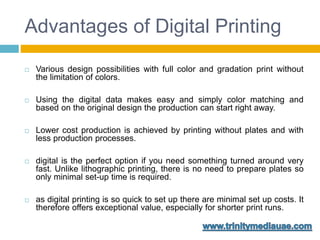The 8-Second Trick For Digital Printing
The 8-Second Trick For Digital Printing
Blog Article
Getting The Digital Printing To Work
Table of ContentsDigital Printing - An OverviewNot known Details About Digital Printing An Unbiased View of Digital PrintingNot known Incorrect Statements About Digital Printing The Definitive Guide for Digital PrintingGetting My Digital Printing To Work
Variable information printing, such as straight mail with individualized codes and addresses, is preferably fit for electronic printing. Digital quick printing only needs 4 steps of layout, testimonial, printing and binding to get whatever done. Digital quick printing has an unparalleled advantage: print on need.According to PMMI, electronic printing permits brand names and makers to respond quickly to consumer demands while improving the supply chain, decreasing warehousing price and waste, and appreciating faster time to market. That all noises great, but how does this technology do all that? The major differentiator of these modern technologies is that there are no set up fees and no plates with electronic printing.
About Digital Printing
According to Wikipedia, the best distinction between digital printing and typical approaches such as lithography, flexography, gravure, or letterpress - Digital Printing is that there is no requirement to change printing plates in digital printing, whereas in these analog printing approaches home plates are repeatedly changed. This causes quicker turnaround time and reduces expense when making use of electronic printing.
Speedy production indicates obtaining your product to market much faster. It also indicates it's much easier and faster to make adjustments later, when you change a recipe, include a SKU, or develop seasonal product packaging. Digital printing is extremely adaptable, so it's easy to make modifications to the bundle layout swiftly. Everything goes back to the plates.
A lot more supply can imply more waste later on. With standard printing methods, short-run printing is just not feasible. Because an excellent style can make or damage your item, digital printing constantly produces premium, clear and vibrant graphics each time. Digital printing on versatile pouches includes the intense, lively, and precise graphics that almost bid consumers to reach out and touch them.
Digital printing is the procedure of printing digital-based photos directly onto a variety of media substrates. There is no need for a printing plate, unlike with offset printing. Digital documents such as PDFs or desktop posting data can be sent straight to the digital printing press to publish on paper, image paper, canvas, fabric, synthetics, cardstock and other substrates.
The Facts About Digital Printing Uncovered
According to PMMI, digital printing allows brands and makers to respond quickly to consumer needs while boosting the supply chain, reducing warehousing price and waste, and appreciating faster time to market. That a knockout post all sounds excellent, but exactly how does this technology do all that? The significant differentiator of these modern technologies is that there are no set up fees and no plates with digital printing.
This results in quicker turnaround time and lowers expense when utilizing electronic printing.

Digital Printing Can Be Fun For Everyone
With standard printing approaches, short-run printing is simply not possible. Since a great layout can make or damage your item, digital printing regularly creates high-grade, clear and colorful graphics each time.

According to PMMI, electronic printing enables brands and makers to respond rapidly to client demands while enhancing the supply chain, decreasing warehousing cost and waste, and taking pleasure in faster time to market. That all sounds terrific, however how does this technology do all that? The significant differentiator of these innovations is that there are no set-up charges and no plates with electronic printing.
All about Digital Printing
According to Wikipedia, the greatest distinction between electronic printing and standard methods such as lithography, flexography, gravure, or letterpress is that there is no demand to change printing plates in digital printing, whereas in these analog printing approaches home plates are repeatedly changed. This results in quicker turn-around time and reduces expense when using digital printing.
Digital printing is very versatile, so it's easy to make adjustments to the package style quickly. It all goes back to the plates.

About Digital Printing
Digital printing is the process of printing digital-based pictures directly onto a selection of media substrates. There is no requirement for a printing plate, unlike with offset printing. Digital documents such as PDFs or desktop computer publishing files can be sent out straight to the digital this page printing machine to print on paper, image paper, canvas, fabric, synthetics, cardstock and other substratums.
Report this page